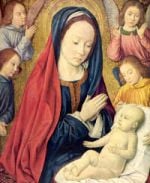We hail you, O Cross of Christ!
1. "Blessed is the King who comes in the name of the Lord!" (Lk 19:38).
Palm Sunday enables us to relive Jesus' entry into Jerusalem shortly before Passover. The Gospel passage presents him to us entering the city surrounded by a festive crowd. We can say that, on that day, Israel's expectations of the Messiah reached their peak. They were expectations fostered by the words of the ancient prophets and confirmed by Jesus of Nazareth through his teaching and, especially, through the signs he performed.
When the Pharisees asked him to silence the crowd, Jesus replied: "If these were silent, the very stones would cry out" (Lk 19:40). He was particularly referring to the walls of the temple in Jerusalem, built for the Messiah's coming and very carefully rebuilt after being destroyed at the time of the deportation to Babylon. Israel had a conscious and vivid memory of the destruction and rebuilding of the temple, and Jesus referred to this awareness when he said: "Destroy this temple, and in three days I will raise it up" (Jn 2:19). As the ancient temple of Jerusalem was destroyed and rebuilt, so the new and perfect temply of Jesus' body was to die on the Cross and rise again on the third day (cf. ibid., 2:21-22).
2. However, as he enters Jerusalem, Jesus knows that the rejoicing by some in the crowd is leading him into the heart of the "mysterium" of salvation. He is aware that he is going to his death and will not receive a royal crown, but one of thorns.
The readings for today's celebration are marked by the Messiah's suffering and culminate in the Evangelist Luke's description of it in the Passion account. This unspeakable mystery of pain and love is presented by the prophet Isaiah, considered in a way as the evangelist of the Old Testament, as well as by the responsorial psalm and the refrain sung a few moments ago: "My God, my God, why have you abandoned me?". St Paul takes it up again in the Letter to the Philippians, which is the inspiration for the antiphon that will accompany us during the "Triduum Sacrum": "Christ became obedient for us unto death, even death on a cross" (cf. 2:8). At the Easter Vigil we will add: "Therefore God has highly exalted him and bestowed on him the name which is above every name" (Phil 2:9).
Every day during the Eucharistic celebration the Church recalls the Lord's Passion, Death and Resurrection — the faithful say after the consecration: "Christ has died, Christ is risen, Christ will come again".
3. For over 10 years Palm Sunday has become an eagerly awaited gathering for the celebration of World Youth Day. The fact that the Church pays special attention to young people on this particular day is in itself very significant. This is not only because 2,000 years ago young people — pueri Hebraeorum — festively accompanied Christ during his triumphal entry into Jerusalem, but especially because, after 20 centuries of Christian history, young people, led by their perceptiveness and a correct insight, are discovering in the liturgy of Palm Sunday a message uniquely addressed to the them.
Dear young people, today the message of the Cross is offered to you again. You, who will be the adults of the third millennium, are entrusted with this Cross which in a few minutes will be passed from a group of French youths to young people representing Rome and Italy. From Rome to Buenos Aires; from Buenos Aires to Santiago de Compostela; from Santiago de Compostela to Czéstochowa; from Jasna Góra to Denver; from Denver to Manila; from Manila to Paris, this Cross has been on pilgrimage with young people from one country to another, from one continent to another. Your choice, young Christians, is clear: to discover in the Cross of Christ the meaning of your life and the source of your missionary enthusiasm.
Starting today, this Cross will go on pilgrimage in the Dioceses of Italy until the World Youth Day of the Year 2000, which will be celebrated here in Rome during the Great Jubilee. Then, with the arrival of the new millennium, it will continue its travels around the world, thus showing that the Cross journeys with young people and young people journey with the Cross.
4. How can we not give thanks to Christ for the exceptional way that young believers have joined forces? At this time I would like to thank all those who have guided young people in this providential activity and have contributed to the great pilgrimage of the Cross along the paths of the world. I am especially thinking, with affection and gratitude, of Cardinal Eduardo Pironio, who died recently. He was present at and presided over many celebrations of World Youth Day. May the Lord shower upon him the heavenly rewards promised to good and faithful servants!
In a few minutes, as the Cross is being symbolically passed from Paris to Rome, allow the Bishop of this city to exclaim with the liturgy: Ave Crux, spes unica! We hail you, O holy Cross! You bring us the One who 20 centuries ago was acclaimed in Jerusalem by other young people and by the crowd: "Blessed is he who comes in the name of the Lord".
We all join in this song, repeating: Blessed is he who comes in the name of the Lord!
Yes! Blessed are you, O Christ, who also comes to us today with your message of love and life. And blessed is your holy Cross, from which flows the salvation of the world yesterday, today and forever.
Ave Crux! Praised be Jesus Christ.
This item 330 digitally provided courtesy of CatholicCulture.org






